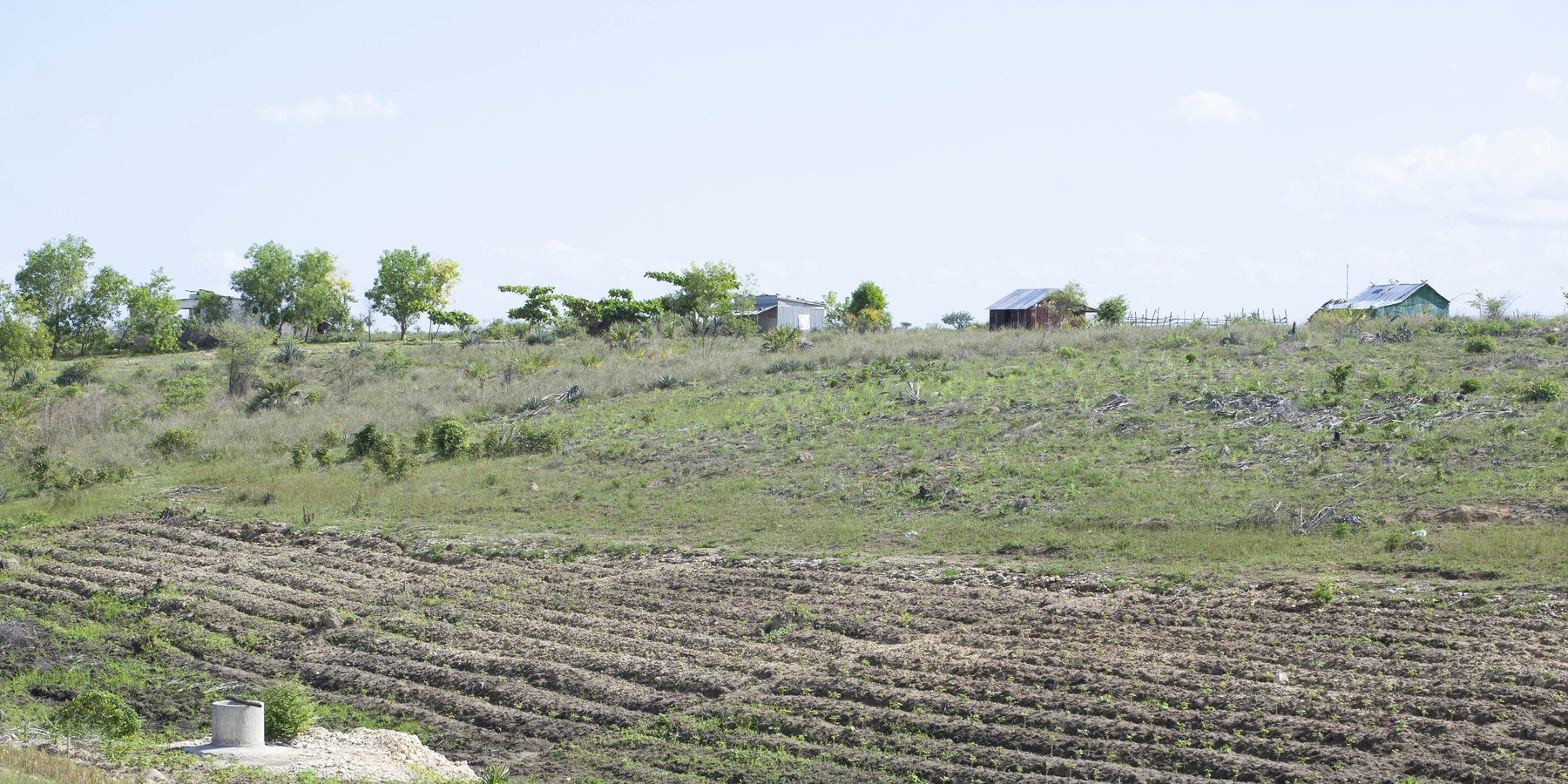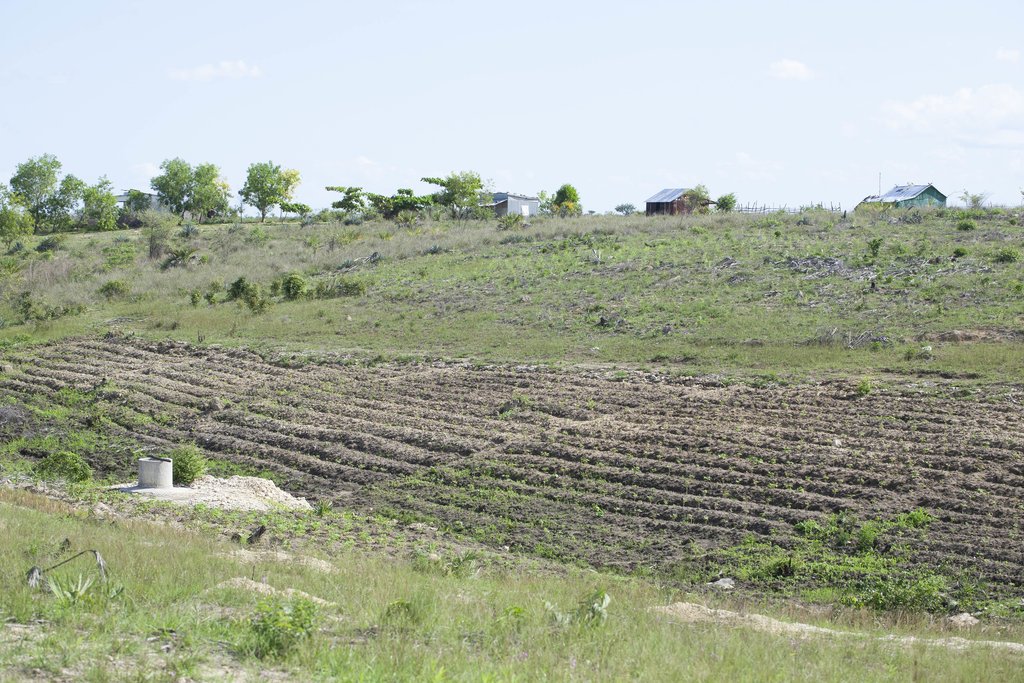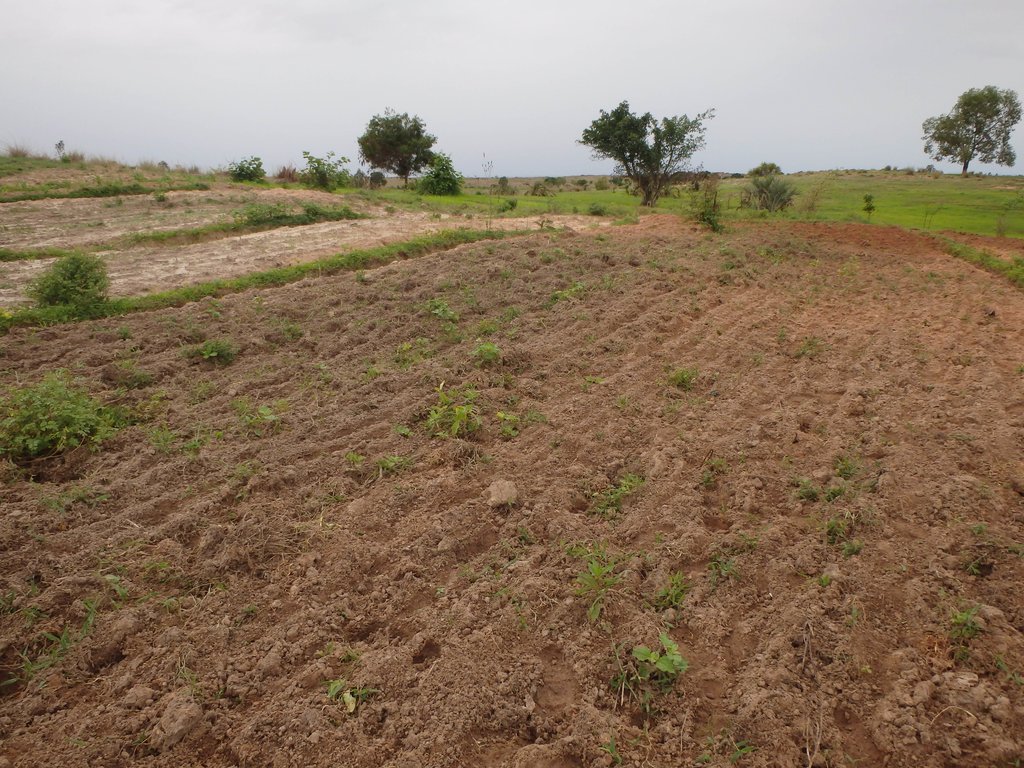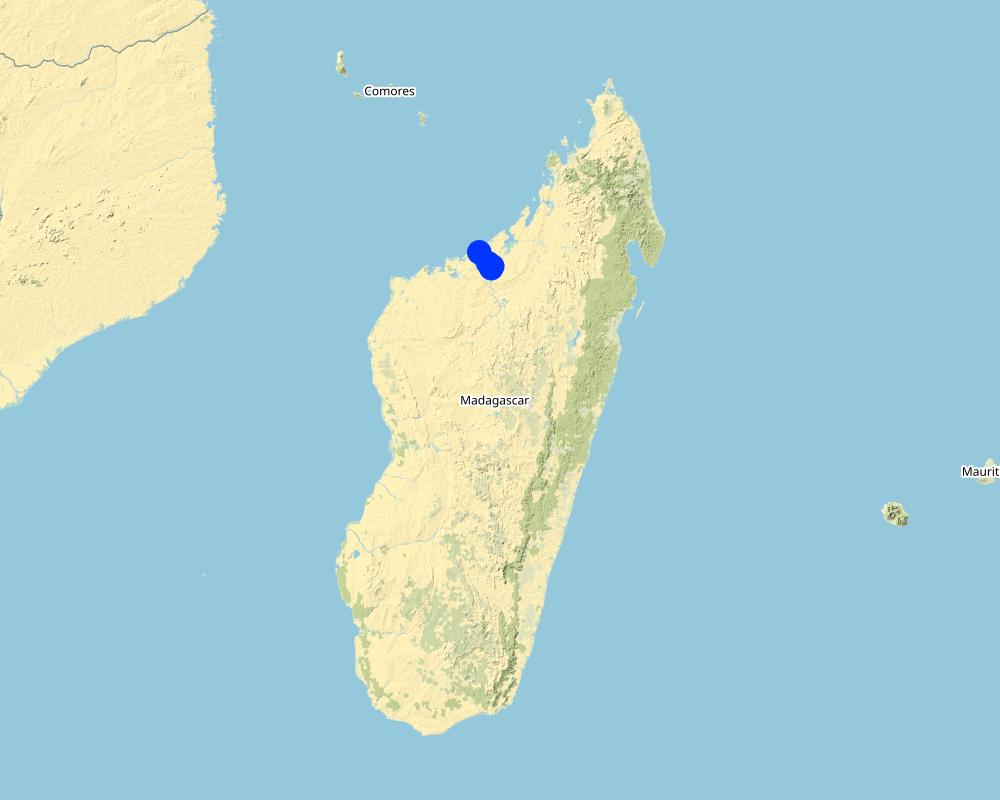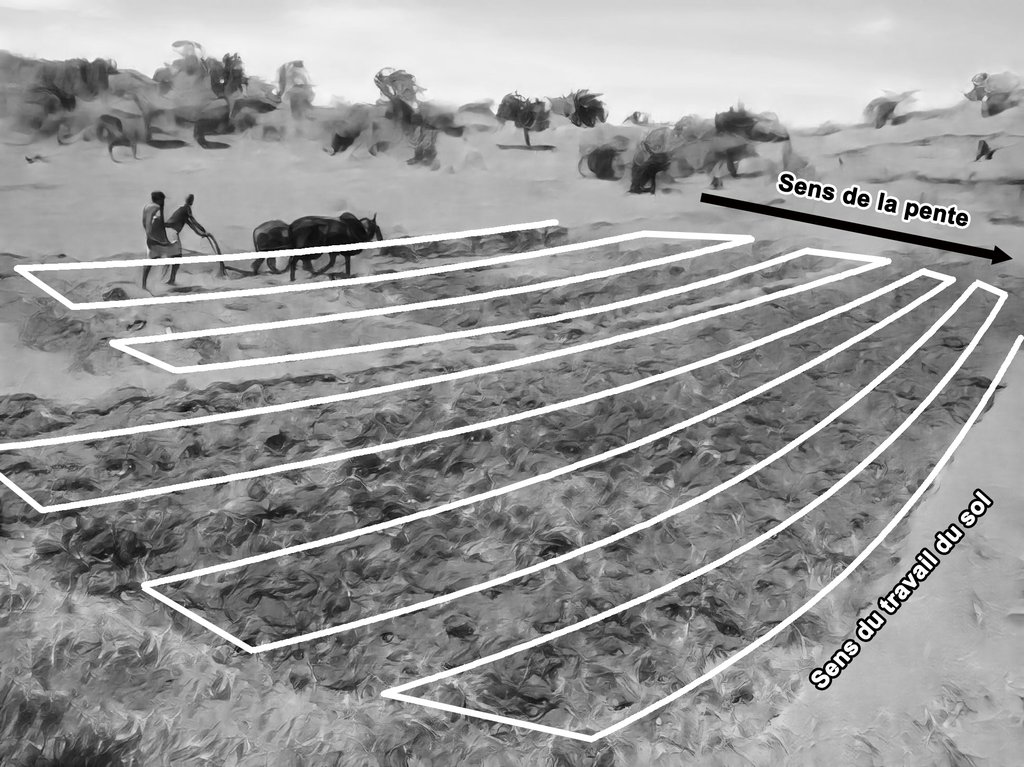Travail du sol perpendiculaire à la pente [Madagascar]
- Creation:
- Update:
- Compiler: Harifidy RAKOTO RATSIMBA
- Editors: Felana Nantenaina RAMALASON, Dimby RAHERINJATOVOARISON, Siagbé Golli, Tahiry Ravivonandrasana, Natacha Rabeary
- Reviewers: William Critchley, Rima Mekdaschi Studer
Fiasana tany mifanohitra amin'ny fisolampy ny tany
technologies_6479 - Madagascar
View sections
Expand all Collapse all1. General information
1.2 Contact details of resource persons and institutions involved in the assessment and documentation of the Technology
Key resource person(s)
land user:
ANDRIANALISON Dod
Madagascar
land user:
RATOVONIRINA Alison Johnny
Madagascar
land user:
RABEMANANJARA Daniel
Madagascar
land user:
ANDRIATIANA Guillaume Sylver
Madagascar
land user:
RANDRIANANDRASANA Tsimihery Jean
Madagascar
Name of project which facilitated the documentation/ evaluation of the Technology (if relevant)
Soil protection and rehabilitation for food security (ProSo(i)l)Name of the institution(s) which facilitated the documentation/ evaluation of the Technology (if relevant)
Deutsche Gesellschaft für Internationale Zusammenarbeit (GIZ)1.3 Conditions regarding the use of data documented through WOCAT
The compiler and key resource person(s) accept the conditions regarding the use of data documented through WOCAT:
Yes
1.4 Declaration on sustainability of the described Technology
Is the Technology described here problematic with regard to land degradation, so that it cannot be declared a sustainable land management technology?
No
2. Description of the SLM Technology
2.1 Short description of the Technology
Definition of the Technology:
Le travail du sol perpendiculaire à la pente consiste à privilégier les labours dans le sens perpendiculaire à la pente, même lorsqu’il semble plus pratique de labourer dans le sens de la pente. Le but de cette pratique est de limiter l’érosion par ruissellement.
2.2 Detailed description of the Technology
Description:
Le travail du sol perpendiculaire à la pente se pratique sur tous les sols de pente légère (< 3 à 5%). Il est nécessaire de combiner le travail du sol avec d’autres dispositifs de lutte antiérosive sur les terres présentant des pentes plus fortes (< 10%), tels que l'utilisation des bandes enherbées. Néanmoins, la culture sur les pentes très fortes est déconseillée en raison de leur exposition forte à l’érosion. De ce fait, leur mise en défens est plus judicieuse.
Cette technologie augmente la quantité d’eau disponible pour les plantes dans le sol et bloque l’écoulement de la couche superficielle du sol, en limitant la prise de vitesse de l’eau lors du ruissellement.
En ce qui concerne l’aspect foncier, les parcelles des exploitants issues d’un héritage sont généralement divisées en bandes étroites dans le sens de la pente pour que chaque enfant dispose des terres de fertilité équivalente. Pourtant lorsque la parcelle est étroite, le travail du sol perpendiculairement à la pente pose des contraintes :
- il faut faire davantage de passages et cela prend donc plus de temps ;
- l’inclinaison des terrains pose parfois de difficulté à maintenir la stabilité de la charrue ;
- dans le cas d’usage de charrue à simple soc et si la pente est un peu forte, il y a un sens de passage particulièrement difficile. Dans ce cas, l’investissement dans une charrue à double soc peut constituer une solution.
La pratique idéale pour le travail du sol est de suivre les courbes de niveau, mais cette recommandation est parfois difficile, voire inapplicable quand les reliefs sont vallonnés et irréguliers. Le traçage de courbe de niveau est aussi une tâche qui peut être trop contraignante pour certains paysans. Dans ce cas, l’identification d’un sens préférentiel pour le labour est une préconisation applicable, même sans suivre rigoureusement les courbes de niveau.
Ce type de travail du sol protège non seulement les parcelles en aval contre les apports de sables et de sédiments, mais empêche également la perte de sol utile et permet ainsi une meilleure infiltration d'eau.
La pratique de cette technique facilite la conservation des matières organiques provenant des résidus de cultures et favorise la vie biologique dans le sol.
Une charrue attelée à des bœufs est parfois difficile à tenir suivant les courbes de niveau sur les sols en pente à cause de l’inclinaison du terrain et de l’instabilité de l’outil.
2.3 Photos of the Technology
2.5 Country/ region/ locations where the Technology has been applied and which are covered by this assessment
Country:
Madagascar
Region/ State/ Province:
Boeny
Further specification of location:
Belobaka, Antanambao Andranolava, Marovoay Banlieue
Specify the spread of the Technology:
- evenly spread over an area
If precise area is not known, indicate approximate area covered:
- < 0.1 km2 (10 ha)
Is/are the technology site(s) located in a permanently protected area?
No
Map
×2.6 Date of implementation
Indicate year of implementation:
2021
If precise year is not known, indicate approximate date:
- less than 10 years ago (recently)
2.7 Introduction of the Technology
Specify how the Technology was introduced:
- as part of a traditional system (> 50 years)
- through projects/ external interventions
Comments (type of project, etc.):
GIZ ProSol Madagascar
3. Classification of the SLM Technology
3.1 Main purpose(s) of the Technology
- improve production
- reduce, prevent, restore land degradation
- protect a watershed/ downstream areas – in combination with other Technologies
- create beneficial economic impact
3.2 Current land use type(s) where the Technology is applied
Land use mixed within the same land unit:
Yes
Specify mixed land use (crops/ grazing/ trees):
- Agroforestry

Cropland
- Annual cropping
Annual cropping - Specify crops:
- cereals - maize
- cereals - rice (upland)
- cereals - sorghum
- legumes and pulses - beans
- legumes and pulses - peas
- legumes and pulses - soya
- root/tuber crops - cassava
- Niébés
Number of growing seasons per year:
- 1
Is intercropping practiced?
Yes
If yes, specify which crops are intercropped:
Maïs et haricot mungo
Maïs et niébés
Is crop rotation practiced?
Yes
If yes, specify:
Pour l'année n, association de cultures de céréales et de légumineuses. Pour l'année n+1, culture de riz. Pour l'année n+2, culture de manioc et ainsi de suite.
3.3 Has land use changed due to the implementation of the Technology?
Has land use changed due to the implementation of the Technology?
- No (Continue with question 3.4)
3.4 Water supply
Water supply for the land on which the Technology is applied:
- rainfed
3.5 SLM group to which the Technology belongs
- improved ground/ vegetation cover
- cross-slope measure
3.6 SLM measures comprising the Technology

agronomic measures
- A1: Vegetation/ soil cover
- A3: Soil surface treatment
A3: Differentiate tillage systems:
A 3.3: Full tillage (< 30% soil cover)

structural measures
3.7 Main types of land degradation addressed by the Technology

soil erosion by water
- Wt: loss of topsoil/ surface erosion
3.8 Prevention, reduction, or restoration of land degradation
Specify the goal of the Technology with regard to land degradation:
- reduce land degradation
4. Technical specifications, implementation activities, inputs, and costs
4.1 Technical drawing of the Technology
Technical specifications (related to technical drawing):
Le travail du sol avec la charrue ou la bêche se fait perpendiculairement au sens de la pente du bas vers le haut. Les paysans ne laissent pas d'espace entre chaque sillon mais labourent la totalité de la parcelle.
Eventuellement, les exploitants peuvent piqueter les courbes de niveau avant le travail du sol et les sillons doivent être tracés suivant ces courbes.
Author:
GIZ ProSol Madagascar
Date:
01/02/2023
4.2 General information regarding the calculation of inputs and costs
Specify how costs and inputs were calculated:
- per Technology area
Indicate size and area unit:
1 hectare
other/ national currency (specify):
ariary
If relevant, indicate exchange rate from USD to local currency (e.g. 1 USD = 79.9 Brazilian Real): 1 USD =:
4300.0
Indicate average wage cost of hired labour per day:
7500
4.3 Establishment activities
| Activity | Timing (season) | |
|---|---|---|
| 1. | Travail du sol suivant les courbes de niveau (charrue + herse) | Novembre - Décembre |
4.4 Costs and inputs needed for establishment
| Specify input | Unit | Quantity | Costs per Unit | Total costs per input | % of costs borne by land users | |
|---|---|---|---|---|---|---|
| Equipment | Travail du sol suivant les courbes de niveau (charrue + herse) | traction animale | 5.0 | 12000.0 | 60000.0 | 100.0 |
| Equipment | Bêche | Nombre | 5.0 | 12000.0 | 60000.0 | 100.0 |
| Equipment | Pelle | Nombre | 1.0 | 250000.0 | 250000.0 | 100.0 |
| Equipment | Charrue | Nombre | ||||
| Total costs for establishment of the Technology | 370000.0 | |||||
| Total costs for establishment of the Technology in USD | 86.05 | |||||
Comments:
L'achat des matériels est assuré en totalité par les exploitants, mais ils les ont déjà à disposition en principe. Le projet s'occupe de leur formation dans l'application de la technique.
4.5 Maintenance/ recurrent activities
| Activity | Timing/ frequency | |
|---|---|---|
| 1. | Travail du sol perpendiculairement à la pente (charrue + herse) | Novembre - Décembre |
4.6 Costs and inputs needed for maintenance/ recurrent activities (per year)
| Specify input | Unit | Quantity | Costs per Unit | Total costs per input | % of costs borne by land users | |
|---|---|---|---|---|---|---|
| Equipment | Travail du sol perpendiculairement à la pente (charrue + herse) | traction animale | 10.0 | 20000.0 | 200000.0 | 100.0 |
| Total costs for maintenance of the Technology | 200000.0 | |||||
| Total costs for maintenance of the Technology in USD | 46.51 | |||||
4.7 Most important factors affecting the costs
Describe the most determinate factors affecting the costs:
Equipements et mains-d'œuvre pour la mise en place de la technologie
5. Natural and human environment
5.1 Climate
Annual rainfall
- < 250 mm
- 251-500 mm
- 501-750 mm
- 751-1,000 mm
- 1,001-1,500 mm
- 1,501-2,000 mm
- 2,001-3,000 mm
- 3,001-4,000 mm
- > 4,000 mm
Specify average annual rainfall (if known), in mm:
1400.00
Agro-climatic zone
- sub-humid
5.2 Topography
Slopes on average:
- flat (0-2%)
- gentle (3-5%)
- moderate (6-10%)
- rolling (11-15%)
- hilly (16-30%)
- steep (31-60%)
- very steep (>60%)
Landforms:
- plateau/plains
- ridges
- mountain slopes
- hill slopes
- footslopes
- valley floors
Altitudinal zone:
- 0-100 m a.s.l.
- 101-500 m a.s.l.
- 501-1,000 m a.s.l.
- 1,001-1,500 m a.s.l.
- 1,501-2,000 m a.s.l.
- 2,001-2,500 m a.s.l.
- 2,501-3,000 m a.s.l.
- 3,001-4,000 m a.s.l.
- > 4,000 m a.s.l.
Indicate if the Technology is specifically applied in:
- not relevant
5.3 Soils
Soil depth on average:
- very shallow (0-20 cm)
- shallow (21-50 cm)
- moderately deep (51-80 cm)
- deep (81-120 cm)
- very deep (> 120 cm)
Soil texture (topsoil):
- coarse/ light (sandy)
- medium (loamy, silty)
Soil texture (> 20 cm below surface):
- fine/ heavy (clay)
Topsoil organic matter:
- high (>3%)
- medium (1-3%)
5.4 Water availability and quality
Ground water table:
5-50 m
Availability of surface water:
good
Water quality (untreated):
poor drinking water (treatment required)
Water quality refers to:
ground water
Is water salinity a problem?
No
Is flooding of the area occurring?
No
5.5 Biodiversity
Species diversity:
- medium
Habitat diversity:
- low
Comments and further specifications on biodiversity:
Plusieurs espèces faunistiques et floristiques sont présentes dans cette Région, certaines sont même endémiques. Néanmoins, cette quantité reste moyenne par rapport à d'autres Régions de l'île. Concernant les habitats, environ 20% de la zone peut constituer un habitat pour cette biodiversité (forêts, plan d'eau, mangrove, etc.), ce qui reste assez faible.
5.6 Characteristics of land users applying the Technology
Sedentary or nomadic:
- Sedentary
Market orientation of production system:
- subsistence (self-supply)
- mixed (subsistence/ commercial)
Off-farm income:
- less than 10% of all income
Relative level of wealth:
- poor
- average
Individuals or groups:
- individual/ household
- groups/ community
Level of mechanization:
- manual work
- animal traction
Gender:
- women
- men
Age of land users:
- youth
- middle-aged
5.7 Average area of land used by land users applying the Technology
- < 0.5 ha
- 0.5-1 ha
- 1-2 ha
- 2-5 ha
- 5-15 ha
- 15-50 ha
- 50-100 ha
- 100-500 ha
- 500-1,000 ha
- 1,000-10,000 ha
- > 10,000 ha
Is this considered small-, medium- or large-scale (referring to local context)?
- small-scale
- medium-scale
5.8 Land ownership, land use rights, and water use rights
Land ownership:
- individual, not titled
- individual, titled
Land use rights:
- leased
- individual
Water use rights:
- open access (unorganized)
Are land use rights based on a traditional legal system?
No
5.9 Access to services and infrastructure
health:
- poor
- moderate
- good
education:
- poor
- moderate
- good
technical assistance:
- poor
- moderate
- good
employment (e.g. off-farm):
- poor
- moderate
- good
markets:
- poor
- moderate
- good
energy:
- poor
- moderate
- good
roads and transport:
- poor
- moderate
- good
drinking water and sanitation:
- poor
- moderate
- good
financial services:
- poor
- moderate
- good
6. Impacts and concluding statements
6.1 On-site impacts the Technology has shown
Socio-economic impacts
Production
crop production
crop quality
Income and costs
workload
Ecological impacts
Water cycle/ runoff
surface runoff
Soil
soil moisture
soil loss
Specify assessment of on-site impacts (measurements):
Il s'agit des estimations des exploitants enquêtés.
6.2 Off-site impacts the Technology has shown
downstream siltation
Comments/ specify:
Positif
damage on neighbours' fields
Specify assessment of off-site impacts (measurements):
Il s'agit des estimations des exploitants enquêtés.
6.3 Exposure and sensitivity of the Technology to gradual climate change and climate-related extremes/ disasters (as perceived by land users)
Climate-related extremes (disasters)
Meteorological disasters
| How does the Technology cope with it? | |
|---|---|
| tropical storm | moderately |
| local rainstorm | moderately |
6.4 Cost-benefit analysis
How do the benefits compare with the establishment costs (from land users’ perspective)?
Short-term returns:
slightly negative
Long-term returns:
positive
How do the benefits compare with the maintenance/ recurrent costs (from land users' perspective)?
Short-term returns:
positive
Long-term returns:
very positive
6.5 Adoption of the Technology
- 1-10%
Of all those who have adopted the Technology, how many did so spontaneously, i.e. without receiving any material incentives/ payments?
- 91-100%
6.6 Adaptation
Has the Technology been modified recently to adapt to changing conditions?
No
6.7 Strengths/ advantages/ opportunities of the Technology
| Strengths/ advantages/ opportunities in the land user’s view |
|---|
| Augmentation de la production agricole due à la réduction de l'érosion hydrique de surface, donc le sol retient plus d'eau et de couche arable utilisées par les cultures. |
6.8 Weaknesses/ disadvantages/ risks of the Technology and ways of overcoming them
| Weaknesses/ disadvantages/ risks in the land user’s view | How can they be overcome? |
|---|---|
| Le labour perpendiculaire à la pente est difficile à réaliser si les parcelles sont trop étroites. | Utilisation de charrues réversibles. |
7. References and links
7.1 Methods/ sources of information
- field visits, field surveys
5 terrains visités
- interviews with land users
5 exploitants interrogés
- compilation from reports and other existing documentation
Fiche technique GIZ ProSol Madagascar
When were the data compiled (in the field)?
31/01/2023
7.2 References to available publications
Title, author, year, ISBN:
Région Boeny, 2016, "Schéma Régional d’Aménagement du Territoire de la Région Boeny"
Available from where? Costs?
Hotel de la Région Boeny
7.3 Links to relevant online information
Title/ description:
Jacques Beauchamp, "LA LUTTE CONTRE L’EROSION DES SOLS DANS LES REGIONS DE GRANDES CULTURES"
URL:
https://www.u-picardie.fr/beauchamp/mst/Erosion_sol/Erosion-sol.htm
Title/ description:
"Taille, forme et orientation des parcelles"
URL:
https://agripedia.ch/erosion/taille-forme-et-orientation-des-parcelles/
Title/ description:
"Le travail du sol perpendiculaire à la pente"
URL:
https://soatany.org/fiches-techniques/
Links and modules
Expand all Collapse allLinks
No links
Modules
No modules


